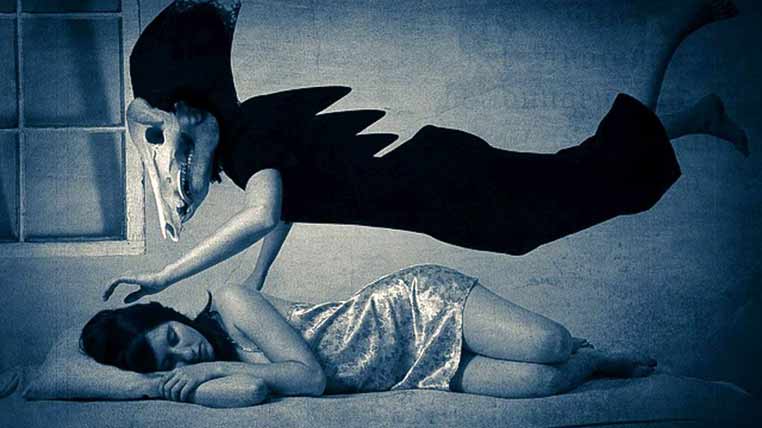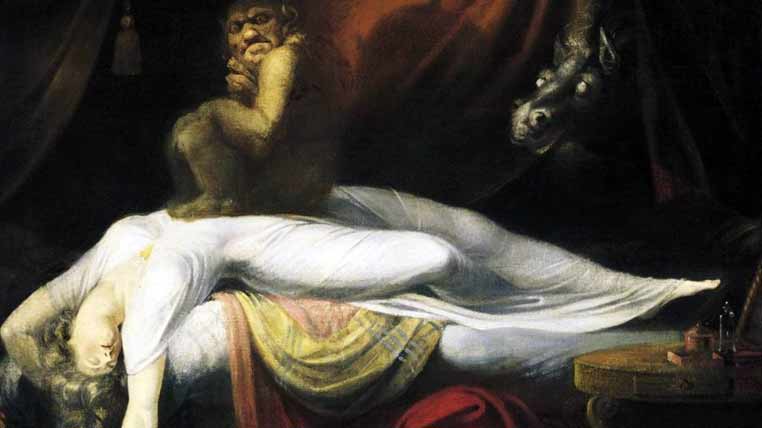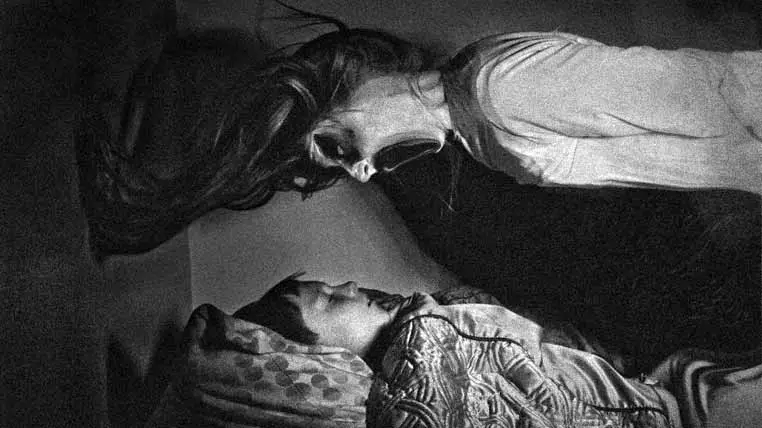Despite its mysterious nature, reports of such occurrences date back to ancient Greece, suggesting that this is not a newly developed medical condition.
But what exactly is sleep paralysis? What are the symptoms of this strange illness, and how do they manifest? Is there a treatment for sleep paralysis? Why do some people who have experienced it claim to be followed by demons?
What is sleep paralysis?
Sleep paralysis is a condition in which a person is temporarily unable to move or speak, often occurring just before falling asleep or upon waking up.
It can be a frightening experience, as the person is fully conscious and aware of their surroundings yet completely immobilized and unable to communicate.
The root cause of this bizarre medical condition is a natural process called muscle atonia, which occurs during REM sleep to prevent the body from physically acting out dreams.
However, when this state persists upon waking up, it can lead to sleep paralysis. While not considered dangerous, it can be a symptom of other sleep disorders or mental health issues.
A typical sleep cycle consists of two distinct stages: Non-REM sleep, which is characterized by partial sleep and easy awakenings, and REM sleep, also known as deep sleep, which is characterized by rapid eye movement and vivid dreams.
Sleep paralysis occurs when a person remains conscious during REM sleep and cannot move or speak for several seconds to several minutes.
Some people who experience sleep paralysis may also feel a sense of suffocation or pressure, and the condition can be accompanied by other sleep disorders such as narcolepsy, an overpowering need to sleep that results from the brain’s inability to regulate sleep patterns.
What are the causes of sleep paralysis?
Sleep paralysis is a perplexing condition that can strike during the onset of sleep (known as hypnagogic paralysis) or upon awakening (hypnopompic paralysis).
Recent studies indicate that this disorder is relatively common, affecting approximately 20% of the population, with symptoms often manifesting in adolescence.
These episodes typically last between one to three minutes, and the phenomenon is more common among young people.
According to a 2011 study published in Sleep Medicine Reviews, around 8% of the general population experiences sleep paralysis at least once in their lifetime, with students being particularly susceptible (up to 28-29%).
Leading sleep expert Dr. Michael Breus posits that stress and sleep deprivation are the primary culprits behind this strange phenomenon. The more fatigued an individual becomes, the greater their chances of experiencing sleep paralysis.
This theory may explain why students, who often endure high-stress levels and sleep deprivation, are among the most prone to this condition.
Additionally, other factors that could contribute to the onset of sleep paralysis include severe fatigue, genetic predisposition, an irregular sleep schedule, sleeping on one’s back, psychiatric disorders such as bipolar disorder, muscle cramps, narcolepsy, hypoglycemia, hypoxia, and metabolic stress.
The exact causes of this medical condition remain a mystery, but ongoing research efforts seek to shed more light on this strange and often unsettling phenomenon.
Ultimately, understanding the underlying factors that contribute to sleep paralysis could help prevent and treat this disorder, bringing much-needed relief to those who suffer from its effects.

How does sleep paralysis manifest?
Over the centuries, sleep paralysis symptoms have been described in many ways, often attributed to a “malevolent presence”: invisible demons, the old witch from William Shakespeare’s “Romeo and Juliet,” extraterrestrials, malevolent entities, spirits, or human-devouring creatures.
According to LiveScience, which cites a study by Brazilian researchers at the Instituto Junguiano da Bahia, all these horror stories result from people’s attempts to explain the strange phenomenon.
According to those affected by this phenomenon, sleep paralysis manifests in several stages.
First, the affected person realizes they cannot move their body and are completely paralyzed. This happens because the body is in a deep sleep, but the brain is still very active.
The inability to move is immediately followed by the sensation of pressure on the chest and the weight of breathing. The patient feels suffocated.
In the darkness, the patient observes a strange silhouette, a shadow that seems to be watching them from the room’s darkest corner.
The demon crawls on the ground until it reaches the edge of the bed and then slowly, methodically climbs onto the paralyzed and defenseless victim. It envelops them completely, and the sensation is one of absolute terror.
What is the sleep paralysis demon?
What is very interesting is how patients describe the sleep paralysis demon, with its physical appearance differing significantly depending on the culture and religion of the observer.
Thus, in some regions of Brazil, there is talk of Pisadeira, an animal with long claws that lurks in the darkness. Pisadeira climbs onto the victim and crushes the sleeping person’s chest under its feet.
Another such legend is that of the creature Pesanta, which originates in the Catalonia region of Spain. There, they speak of a black animal, similar to a dog, which climbs onto the sleeping person’s chest at night, causing them to feel suffocated and experience terrible nightmares.
Also interesting is the legend that circulates in the Newfoundland region of Canada. The people there believe that sleep paralysis indicates the existence of a curse cast by a witch (Old Hag), a kind of “baba-cloanța” specific to Romanian folklore.
The sleep paralysis demon is called a “spirit” in the legends of Vietnam, Laos, and Japan.
In certain ethnic groups in these regions, many symptoms are attributed to a “malevolent spirit or entity” that climbs onto the chest of the person lying in bed, trying to suffocate them.
The idea of pressure on the chest and suffocation is also evident in the terminology used in some regions of Mexico to explain sleep paralysis. An approximate translation of the Spanish phrase is “a corpse placed on top of me.”
In some cultures, sleep paralysis is seen as a spiritual experience, a gateway to another world or dimension, and even a sign of psychic ability. Regardless of how it is interpreted, it remains a mysterious and frightening experience for those who go through it.
Why do we see demons during sleep paralysis?
Several theories explain why people may see demonic or malevolent figures during sleep paralysis.
One theory suggests that the human brain’s fight or flight response is activated during sleep paralysis, leading to intense fear and the perception of a threatening presence.
Another hypothesis suggests that the experience may be influenced by cultural beliefs and media portrayals of demons or supernatural entities. People may be more likely to see figures they have been exposed to in movies, books, or other forms of media.
Additionally, the brain’s state during sleep paralysis may contribute to perceiving demons, as the brain is in partial wakefulness, still processing dream-like images and sensations, but the body cannot move.
This state of consciousness may lead to the perception of hallucinations or illusions, including demonic figures.
According to research conducted in 1999 by members of the Department of Psychology at the University of Waterloo (Ontario, Canada), sleep paralysis can generate four main types of hallucinations.
The Intruder
The most common type of hallucination is the Intruder. The subject feels the presence of an entity in the room.
In rare cases, the person may even see and hear these entities. According to scientists, Intruder hallucination originates in the amygdala, the part of the brain responsible for the sensation of fear.
When the amygdala is active, we become vigilant. In the case of sleep paralysis, experts talk about hyper-vigilance with paranoid tendencies that cause the subject to “see” shadows, shapes, and even a foreign presence in the room.

Incubus
In many cultures, incubus demons are often associated with sleep paralysis.
This may be because of the common experience of feeling a weight on the chest or feeling suffocated during sleep paralysis, often described as being caused by an incubus or a similar malevolent spirit.
The incubus is a demon that, according to folklore, attacks women while they sleep, often causing nightmares or erotic dreams.
In the case of sleep paralysis, the incubus may be seen as a malevolent force responsible for the pressure on the chest and the sense of suffocation that can occur during an episode.
The association of incubus demons with sleep paralysis may also be influenced by cultural beliefs and fears about the supernatural.
In many cultures, demons and malevolent spirits are believed to exist and can possess or attack humans, particularly during vulnerable moments such as sleep.
Unusual Bodily Experiences (OBEs)
Unusual Bodily Experiences (UBEs) are associated with this medical condition because they are often reported by individuals who experience episodes of sleep paralysis.
During sleep paralysis, a person may experience a variety of UBEs, including a feeling of floating, levitating, or leaving their physical body.
Some individuals report feeling as if they are being held down or choked, while others may have the sensation of being touched or hearing strange noises.
These experiences can be frightening and may lead to the perception of a presence in the room, such as the feeling of being watched or the presence of an intruder. In some cases, these experiences may be interpreted as supernatural or paranormal in nature.
Individuals diagnosed with sleep paralysis often describe their UBEs as vivid and realistic, with a strong sense of presence and the feeling of being awake.
Some may also experience visual or auditory hallucinations, which can add to the intensity of the experience. The descriptions of UBEs vary widely among individuals and may be influenced by cultural or personal beliefs.
Research suggests that UBEs may be caused by a disruption in the normal processes of REM (rapid eye movement) sleep. During REM sleep, the body is typically paralyzed to prevent the acting out of dreams, but in sleep paralysis, this immobility may persist into wakefulness, leading to UBEs.
Other factors like stress, anxiety, and sleep deprivation may also contribute to UBEs.
How to treat sleep paralysis?
While there is no specific treatment for this bizarre medical condition, it is usually not a serious condition and does not require medical intervention.
In most cases, treatment focuses on addressing underlying conditions such as sleep disorders, anxiety, or depression that may be contributing to the experience of sleep paralysis.
For example, if a person has a sleep disorder such as narcolepsy, their doctor may prescribe medication to help manage their symptoms. If the person is experiencing anxiety or depression, they may be referred to a mental health professional for therapy or medication management.
In addition, some lifestyle changes may help prevent sleep paralysis episodes, such as maintaining a regular sleep schedule, practicing good sleep hygiene, avoiding alcohol and drugs, and managing stress levels.
It is important to note that while it can be a frightening experience, it is not typically a sign of a severe medical condition and does not usually require medication.
However, if a person experiences frequent or severe episodes of sleep paralysis that interfere with their quality of life, they should speak with their healthcare provider to rule out any underlying medical or psychiatric conditions.
At Ancient Theory we only use trusted sources to document our articles. Such relevant sources include authentic documents, newspaper and magazine articles, established authors, or reputable websites.
- Sleep paralysis - wikipedia.org. [Source]
- Sabrina Felson - Is Sleep Paralysis a Symptom of a Serious Problem? [Source]
- Kathleen Davis - Everything you need to know about sleep paralysis. [Source]
- Nicoletta Lanese - Sleep Paralysis: Causes, Symptoms & Treatment. livescience.com.
- Sleep Paralysis - webmd.com. [Source]
- Night hag - wikipedia.org. [Source]
- Josh K. Elliott - Why the paralyzing ‘sleep demon’ still haunts humans in the age of science. globalnews.ca.


